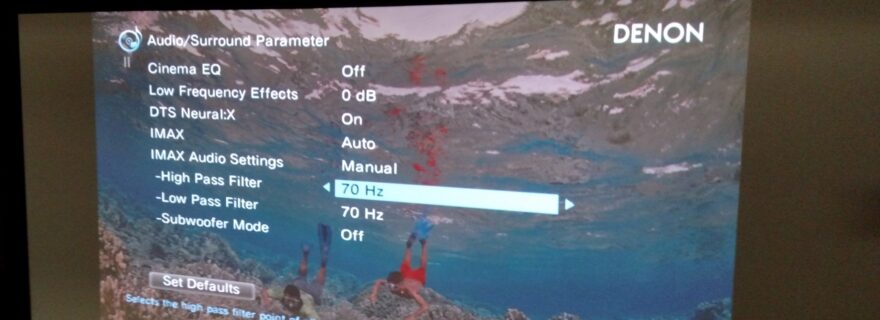Earlier this year, the IMAX Corporation and DTS introduced the new IMAX Enhanced variant of the DTS:X sound format, and I wrote a few articles trying to get to the bottom of what it really is or does. Just as I thought I understood it, a recent firmware update changed some ways the format works.
As a rule, I turn off automatic firmware updates to my Denon AVR-X8500H and only allow one if either something isn’t working or some important new feature has been introduced. This week, I was having problems with the DTS Neural:X upmixer (too complicated and too far off the subject to get into here, but maybe later) and noticed that a new firmware was available for the receiver. Sadly, it didn’t fix my original issue. However, while playing around I noticed a few new settings in the Surround Parameter menu pertaining to the IMAX audio format. As it turns out, new setup features have been added to address criticisms I made previously, while another option has been removed.
What’s New?
In Part 2 of this series, I discovered that turning on the IMAX mode (which is only intended to be used with specially encoded soundtracks that contain an IMAX metadata flag) overrides the receiver’s bass management settings and applies its own default crossover, regardless of what you have manually selected or whether the new setting is even appropriate for your speakers’ capabilities. In testing this, I also found an apparent programming bug where the receiver failed to redirect bass to the “Large” speakers in a system with no subwoofer, and yet inappropriately sent bass to speakers set as “Small” when there is a subwoofer that should get it.
None of these issues endeared the format to me very much.
With the new firmware, the IMAX setup menu now offers the ability to manually set High Pass and Low Pass crossover filters, both of which default to 70 Hz until you change them. Honestly, I don’t understand the purpose of including both. (Receiver crossovers are generally only Low Pass, while the High Pass crossover is fixed.) I don’t understand why 70 Hz was chosen as the default for both. Nor do I understand why the IMAX format needs its own dedicated crossovers and wouldn’t use the global settings you’ve already selected during regular audio calibration, which should apply to everything.
On the one hand, I’m glad to see IMAX acknowledge that completely overriding the global settings with no ability to adjust was a bad idea. These changes also seem to fix the programming bug relating to Large and Small speakers. On the other hand, the settings are still needlessly confusing with little documentation, and are only available at all while playing a disc with an IMAX Enhanced soundtrack. Most people I know do their audio setup and calibration once after buying the receiver (typically using Audyssey or equivalent automated tools) and don’t expect to have to adjust settings again on a case by case basis.
At the end of the day, I fundamentally disagree with the IMAX philosophy of requiring dedicated settings just for IMAX soundtracks that are different than and override the settings for every other type of content. The whole point of these crossover filters is to set them to best match the capabilities of your speakers, and has nothing to do with the content. If your speakers can’t handle bass lower than 80 Hz, then they can’t handle bass lower than 80 Hz, period. Whether that bass is coming from a Dolby, DTS, or IMAX soundtrack is irrelevant. It’s all the same bass! There’s nothing magically different about IMAX bass that will make your speakers play lower than they were designed.
What’s Gone?
Previously, the IMAX mode could be set to Auto (automatically triggered only during playback of soundtracks with an IMAX metadata flag), Off (never engaged, and playing the soundtrack as regular DTS:X instead), or On. The latter could force the IMAX mode under certain circumstances. As I explained in Part 3, the On option was likely intended for streaming delivery of IMAX soundtracks, during which the metadata flag might sometimes be missing. However, it was possible to trick the receiver into applying it to other lossy DTS soundtracks, such as on DVD.
In the new firmware, the On option has been removed. Only Auto or Off are available. I assume this was done to stop people from applying the processing to content it wasn’t intended for. I don’t see this as a big loss (it pretty much made DVD soundtracks sound bad anyway), but I wonder if it means that IMAX has given up on plans to stream its audio format.
What’s the Point, Anyway?
Earlier in the series, I asked whether the extra bass and other tweaking that the IMAX mode applies to a soundtrack were always intended to be part of the movie’s sound design, or if the feature simply cranks up the audio to be more showy. I still don’t have a clear answer on that, but I’m leaning toward the latter explanation.
When I turn IMAX mode on during A Beautiful Planet or Journey to the South Pacific (the only two IMAX Enhanced discs available so far), the bass sounds bloated and boomy to me, and makes human voices sound unnaturally growly and muddy. To be perfectly frank, I think that watching the movies in normal DTS:X format without the IMAX mode sounds better balanced and more natural.
Giving the benefit of the doubt, I may have still not found the right combination of settings to get the most out of IMAX mode with my speakers. Until or unless that happens, however, I’m inclined to feel that the whole thing is just a pointless gimmick.






Bob
I don’t think IMAX enhanced is really a true ‘format’ or codec (like Dolby Atmos or DTS:X).
It’s more for marketing purposes than anything else (tweaking existing settings to give the impression of loudness etc.), much like turning up the color vibrancy on a display to give the impression of a more punchy picture (like in store displays).
I think l will steer clear.
DeAndre Davis
I really enjoy the IMAX Enhanced audio mix. It really brings some titles to life like “Venom”. I compared it to the Dolby Atmos mix and even my wife said the IMAX mix was much better. The Dolby version sounded flat and Venom’s voice did not sound immersive at all. Fandango Now has quite a few titles to select from and some titles sound better on streaming than on the physical disc.
James Russell
IMAX ENHANCED so far has not been very impressive. For one the movies that have been released still have the black bars. From what I have read the original aspect ratio will be used, it’s the DMR process that is applied to the picture. As for the sound, it’s hard to really tell much difference between DTSX and the IMAX version.
I would say that IMAX better get on the ball and soon or this will be another dead format.
Jordan Ketterer
Bob, yes I agree to a point, I think it might be better to compare it to thx, more of a standard or certification then an actual format.
That’s also why it might set the crossovers to 70, they may have plans to certify speakers next and they already certify tvs.
Is not a format really. Just similar to thx, it means you know a specific reference is very before the product is released.
ANDY SUMMERS
Liemax is rubbish and I find to be a scam by the studios for this rubbish Liemax of prefixed freq filters to be a scam. the content is rubbish as always Liemax doesn’t have anything to offer to me. I shall never ever buy any Liemax movies with that rubbish dtshdma and all this Liemaxx dtsx is just another Near Field remix. Total Scam.
Sam
Thanks for going through the weeds on this. Now I know not to fret about it. I would like to find some DTS:X Pro content to try out though 🤔